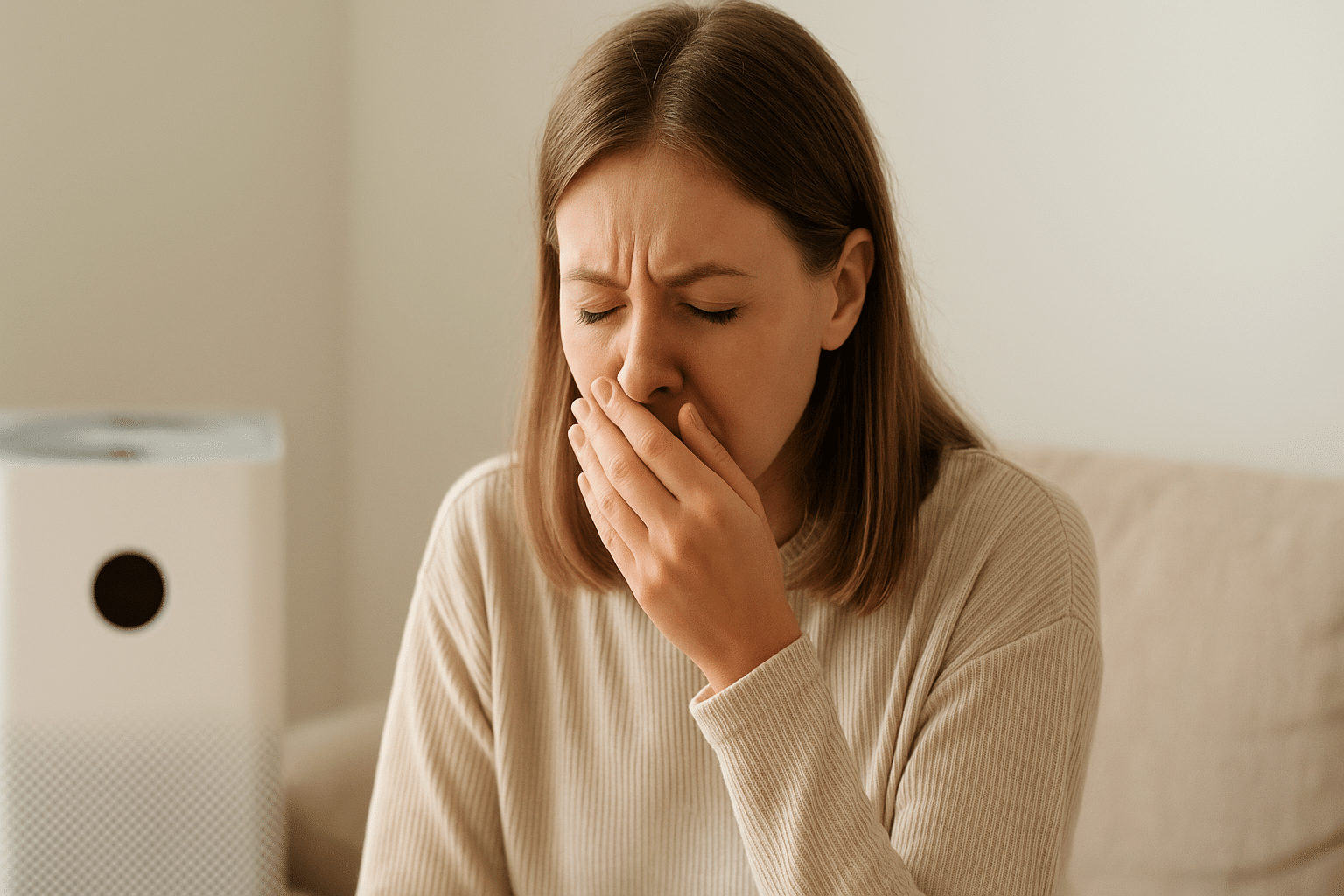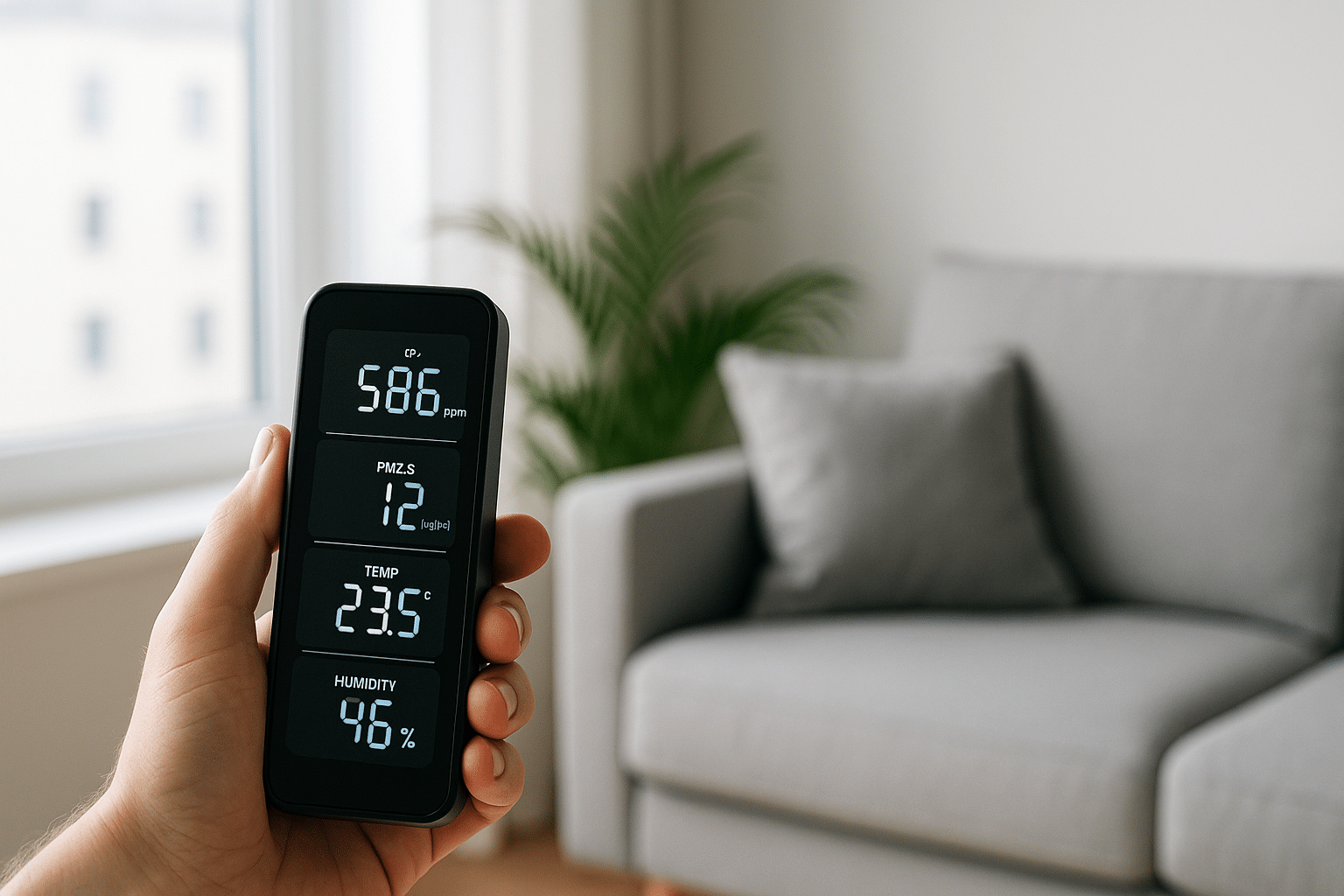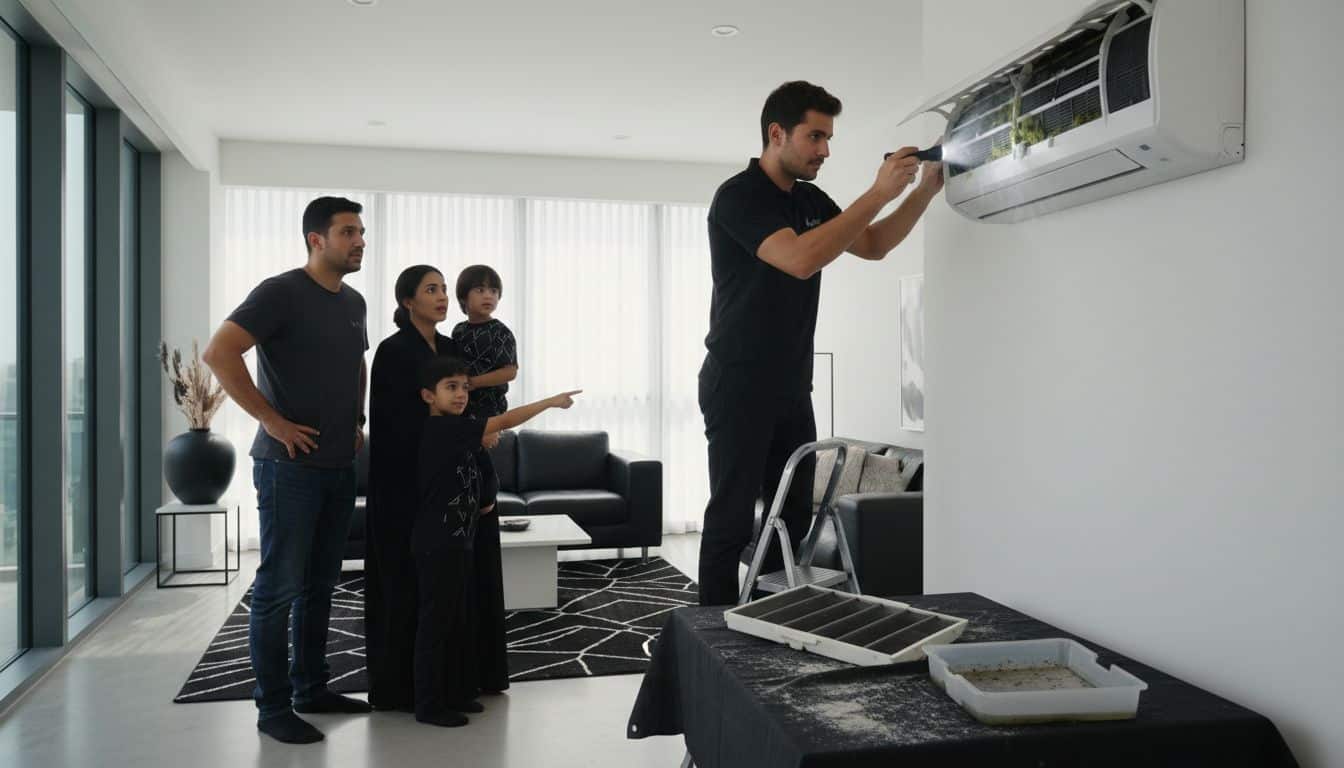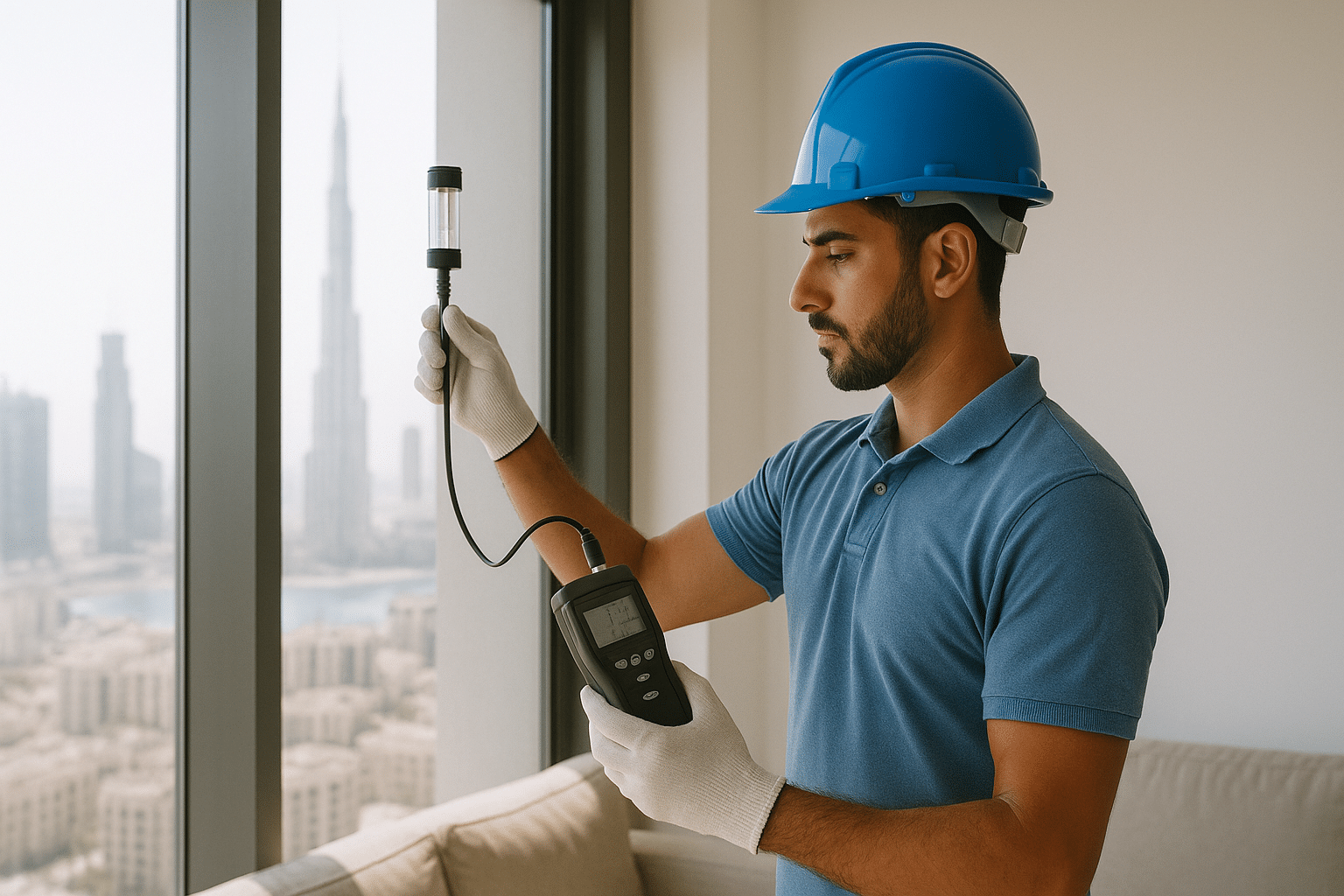
10 Critical Health Risks of Poor Indoor Air Quality and How to Prevent Them
Table of Contents
Contents
- 1 Table of Contents
- 2 Introduction to Health Risks of Poor Indoor Air Quality
- 3 Common Causes of Poor Indoor Air Quality in Dubai
- 4 Health Impacts of Poor Indoor Air Quality
- 5 Who Is Most Vulnerable to Poor Indoor Air Quality?
- 6 Inspection and Monitoring Techniques
- 7 Effective Solutions to Improve Indoor Air Quality
- 8 Professional Cleaning Services and Their Role
- 9 Dubai Regulations and Standards on Indoor Air Quality
- 10 Daily Habits to Maintain Healthy Indoor Air
- 11 Conclusion: Take Action for Healthy Indoor Air in Dubai
Introduction to Health Risks of Poor Indoor Air Quality
The health risks of poor indoor air quality continue to be a growing concern, especially in rapidly urbanizing cities like Dubai. As indoor environments become places where people spend the majority of their time, ensuring clean indoor air is essential not only for comfort but also for long-term health. Poor indoor air quality can silently contribute to many adverse health problems, and understanding these risks is the first step toward creating safer living and working spaces.
In this comprehensive guide, we will explore the critical health issues linked to poor indoor air and provide actionable solutions to improve indoor air quality in your home or office. This article is tailored for Dubai residents and businesses, considering local environmental and regulatory conditions. Understanding the immediate and long-term health risks of poor indoor air quality is paramount for well-being.
Common Causes of Poor Indoor Air Quality in Dubai
Dubai’s rapid development and distinctive climate mean that indoor air quality challenges may be unique compared to other global cities. Recognizing the common causes helps in effectively combating the health risks of poor indoor air quality.
Outdoor Pollution Penetration
Dust storms are frequent in Dubai and the surrounding desert, allowing airborne particles and pollutants to infiltrate buildings. Despite sealed windows, pollutants can enter through ventilation systems, affecting indoor air. Such infiltration directly contributes to the health risks of poor indoor air quality.
Inadequate Ventilation
Many modern buildings prioritize air conditioning efficiency, sometimes reducing fresh air circulation. Stale air trapped indoors concentrates pollutants and allergens, exacerbating health problems. This exacerbates the health risks of poor indoor air quality, making proper ventilation crucial.
Indoor Sources of Pollution
Common household items such as paints, cleaning agents, furniture, carpeting, and cooking fuels emit volatile organic compounds (VOCs) that lower indoor air quality. In Dubai homes and offices, heavy use of air fresheners and cleaning chemicals can worsen indoor pollution. These chemical releases heighten the health risks of poor indoor air quality for occupants.
Humidity and Mold Growth
The climate control systems in Dubai may cause indoor air to become dry, but improper moisture control or leaks lead to mold growth, creating allergens. Such growth significantly adds to the health risks of poor indoor air quality.
Dust and Particulate Matter
Construction activities and heavy traffic within Dubai contribute to airborne dust that settles indoors if not properly filtered by HVAC systems. These airborne particles are key contributors to the health risks of poor indoor air quality.
Health Impacts of Poor Indoor Air Quality
Understanding the scope of health risks of poor indoor air quality is crucial for residents and workers in Dubai.
Indoor air quality (IAQ) is a critical factor impacting public health, especially in fast-growing cities like Dubai where modern buildings and rapid urbanization create environments prone to air contamination. The health risks of poor indoor air quality are increasingly recognized by Dubai’s healthcare authorities and urban regulators such as Dubai Municipality and the Dubai Health Authority (DHA). Understanding these health risks is essential for residents, employers, and building managers to ensure safer indoor environments throughout popular areas like Downtown Dubai, Business Bay, and Dubai Marina.
Respiratory Illnesses
Exposure to indoor pollutants can irritate the respiratory system, causing coughing, wheezing, and shortness of breath. Chronic exposure increases the risk of asthma and bronchitis, conditions that are rising in prevalence in Dubai. This directly illustrates one of the primary health risks of poor indoor air quality.
Respiratory Complications and Chronic Conditions
One of the most immediate and commonly reported consequences of poor indoor air quality is respiratory distress. Pollutants like dust, mold spores, volatile organic compounds (VOCs), and fine particulate matter can irritate the airways and worsen existing respiratory problems. In Dubai, where air-conditioned indoor spaces are heavily relied upon to mitigate the intense desert climate, lack of proper ventilation or inadequate filtration systems can trap pollutants inside, creating a breeding ground for airborne illnesses.
Residents in apartments or offices in areas such as Nad Al Sheba or Arabian Ranches have reported symptoms ranging from mild throat irritation and coughing to severe asthma attacks and exacerbations of chronic obstructive pulmonary disease (COPD). According to Dubai Health Authority guidelines on indoor environmental quality, prolonged exposure to indoor pollutants may also contribute to the development of chronic bronchitis and other long-term respiratory illnesses.
Allergic Reactions
Mold spores, dust mites, and pet dander indoors trigger allergic rhinitis and exacerbations of asthma. Many Dubai families notice these during dust storm seasons due to pollutant accumulation inside. This exacerbation is a common aspect of the health risks of poor indoor air quality.
Allergies and Immune System Impact
Indoor allergens are a persistent problem in many homes and workplaces across Dubai. Common triggers include pet dander, dust mites, and mold. Buildings that do not meet the UAE Fire & Life Safety Code or the Dubai Municipality’s regulations on ventilation and building maintenance often struggle to control these allergens, increasing residents’ vulnerability.
Exposure to poor indoor air quality can overstimulate the immune system, leading to allergic reactions such as sneezing, watery eyes, skin rashes, and even eczema flare-ups. In some cases, repeated exposure can sensitize individuals, making them more prone to allergic diseases or infections. This is a particular concern in Dubai’s humid coastal areas, where mold growth is more prevalent without proper humidity control.
Headaches and Fatigue
Indoor pollutants like VOCs and carbon monoxide contribute to headaches, dizziness, and chronic fatigue, reducing productivity in office environments. Such cognitive impacts are part of the broader health risks of poor indoor air quality.
Cardiovascular Concerns
Recent studies link poor indoor air quality to increased risks of high blood pressure and heart disease. Pollutants entering the bloodstream can cause inflammation and oxidative stress. This represents a significant element of the health risks of poor indoor air quality.
Cognitive Function Decline
Poor air quality negatively impacts concentration, memory, and decision-making abilities, particularly relevant in Dubai’s fast-paced corporate settings. Addressing this concern is vital for mitigating the overall health risks of poor indoor air quality.
Other Significant Health Risks
Beyond respiratory and allergic conditions, poor indoor air quality can affect other bodily systems, creating a wide array of health issues:
- Cardiovascular problems: Fine particulate matter (PM2.5) and chemical pollutants entering the bloodstream can contribute to increased heart rate, hypertension, and higher risk of heart disease. This risk is elevated among vulnerable populations such as the elderly and those with pre-existing conditions.
- Neurological effects: Long-term exposure to indoor air pollutants like carbon monoxide (CO) or formaldehyde may lead to headaches, dizziness, cognitive impairment, and fatigue. The DHA has issued guidelines emphasizing the importance of detecting and mitigating such contaminants to safeguard worker productivity and general well-being.
- Mental health considerations: Emerging research from local Dubai universities suggests a correlation between poor air quality and increased anxiety, depression, and stress levels—factors that can compound the overall health burden experienced by city dwellers.
These 10 health risks illustrate why air quality cannot be overlooked in home and workplace safety planning. Recognizing these diverse health risks of poor indoor air quality is essential for comprehensive safety planning.
Who Is Most Vulnerable to Poor Indoor Air Quality?
Although everyone can be affected by the health risks of poor indoor air quality, certain groups in Dubai require special attention.
- Children: Developing lungs make kids especially vulnerable to pollutants, increasing risks of asthma and developmental issues. Children, for example, inhale more air relative to their body weight and their developing lungs are more easily damaged by airborne toxins. This increases their risk for developmental issues and chronic respiratory diseases.
- Elderly Persons: Age-related respiratory and cardiovascular weaknesses heighten impacts. The elderly, who often have weakened immune systems, may also experience worsened symptoms from exposure to indoor pollutants.
- Individuals with Pre-existing Conditions: Those with asthma, allergies, or heart disease face worsening symptoms.
- Office Workers and Stay-at-Home Residents: Extended time indoors means prolonged exposure.
- Cleaning Staff and Maintenance Workers: They face higher risks due to chemical inhalation without proper protection.
Certain populations are especially susceptible to the health risks of poor indoor air quality in Dubai’s urban context. Pregnant women, and individuals with pre-existing health conditions require targeted attention and protection—something emphasized by the Dubai Health & Safety guidelines.
Inspection and Monitoring Techniques
Proactive detection of indoor air problems is vital. Dubai residents and businesses can adopt several methods to evaluate air quality.
Using Air Quality Monitors
Portable devices measure particulate matter (PM2.5), VOCs, CO2, and humidity, offering real-time data to detect areas requiring improvement.
Professional Indoor Air Quality Inspections
Experts use advanced sampling and analysis to pinpoint sources of contamination, including duct cleaning assessments.
Regular HVAC System Checks
Routine inspection and filter replacement in air conditioning and ventilation systems help maintain airflow quality.
Visual Inspection for Mold
Identifying signs of mold or water damage early allows timely remediation, essential in Dubai’s humid indoor corners.
Effective Solutions to Improve Indoor Air Quality
Combating the health risks of poor indoor air quality requires a layered approach combining prevention and correction.
Enhancing Ventilation
Ensuring adequate fresh air exchange reduces pollutant buildup. Use exhaust fans in kitchens and bathrooms, and consider vented systems when possible.
Using High-Efficiency Filters
Installing HEPA or activated carbon filters within Dubai’s building HVAC systems traps fine particles and VOCs efficiently.
Controlling Humidity
Maintain indoor humidity between 40-60% to inhibit mold growth while avoiding overly dry air that irritates respiratory tracts.
Choosing Low-Emission Products
Select paints, furniture, and cleaning products with low VOC emissions to minimize chemical pollutants indoors.
Regular Cleaning and Dust Removal
Frequent vacuuming with HEPA-filter vacuums and wet mopping reduces dust, pet dander, and allergens.
Professional Cleaning Services and Their Role
In Dubai, professional indoor air quality services play a pivotal role in addressing pollutants that typical cleaning misses. Companies like Saniservice, specialists in addressing the health risks of poor indoor air quality, provide HVAC duct cleaning, mold remediation, and odor removal specifically tailored for Dubai’s climate and building standards.
These professionals use specialized equipment certified by organizations such as the National Air Duct Cleaners Association (NADCA) to combat the health risks of poor indoor air quality, ensuring thorough removal of contaminants.
Choosing certified cleaning services helps Dubai residents and businesses comply with Dubai Municipality’s air quality guidelines while reducing the health risks of poor indoor air quality in their environments.
Dubai Regulations and Standards on Indoor Air Quality
The Dubai Municipality and Dubai Health Authority regulate indoor air quality standards to safeguard public health. Buildings are encouraged to adhere to guidelines that include proper ventilation, use of approved materials, and regular maintenance of HVAC systems.
The Emirates Authority for Standardization and Metrology (ESMA) provides standards on pollutant limits and product safety, influencing indoor air quality management. Following these standards reduces environmental health risks and helps ensure compliance with safety inspections.
Dubai’s growing concern for indoor air cleanliness is driving building codes and environmental policies toward sustainable and health-conscious design.
Mitigating Health Risks through Regulations and Practices
The local authorities in Dubai have introduced comprehensive standards aimed at reducing indoor air pollution and protecting public health. For example, Dubai Municipality enforces strict building codes related to HVAC systems maintenance, filtration standards, and regular indoor air quality assessments. The Dubai Electricity and Water Authority (DEWA) promotes sustainable building designs and energy-efficient cooling systems that help prevent stagnant air and pollutant accumulation.
At a personal and organizational level, improving indoor air quality through practical measures is vital:
- Regular cleaning and maintenance of air conditioning units to prevent mold and bacterial growth
- Ensuring adequate ventilation to circulate fresh air, particularly in high-occupancy spaces like offices in Dubai Marina or Business Bay
- Using low-emission materials and furnishings compliant with Emirates Authority for Standardization and Metrology (ESMA) regulations
- Monitoring indoor humidity levels to prevent dampness and mold, especially during summer months when air conditioning is used intensively
By adhering to these guidelines and fostering awareness around the health risks of poor indoor air quality, Dubai’s residents and businesses can significantly reduce the burden of indoor air pollutants and promote healthier living environments throughout the city.
Daily Habits to Maintain Healthy Indoor Air
Simple daily practices can significantly reduce the health risks of poor indoor air quality, especially in Dubai homes and offices.
- Open windows briefly during cooler hours: This helps flush out indoor pollutants despite the desert climate.
- Limit use of aerosol sprays and strong chemicals: Replace them with natural alternatives when possible.
- Avoid smoking indoors: Tobacco smoke is a major source of indoor pollutants.
- Keep indoor plants: Certain plants help absorb toxins and improve oxygen levels.
- Maintain cleanliness: Reduce dust accumulation and vacuum regularly using HEPA filters.
- Fix leaks immediately: Prevent mold growth by addressing moisture issues promptly.
Conclusion: Take Action for Healthy Indoor Air in Dubai
The health risks of poor indoor air quality present significant challenges but are manageable with knowledge and proactive measures. By understanding the causes, health impacts, and practical solutions tailored for Dubai’s environment, residents and businesses can safeguard their wellbeing effectively.
Investing in inspections, professional cleaning services, and adherence to local regulations ensures long-term respiratory health and comfort. Don’t wait for symptoms—start improving your indoor air quality today for a healthier tomorrow.






Leave a Reply